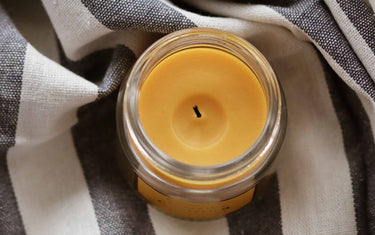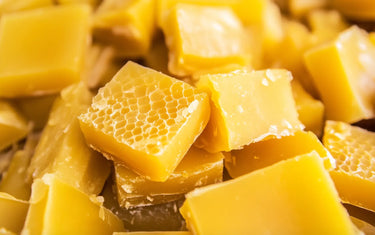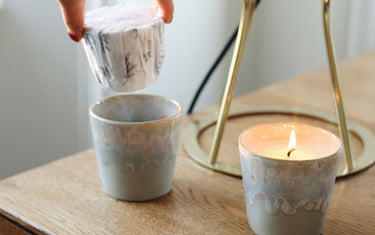6 min read / 28 January 2024 / yasmin sharp
How to Fix Candle Tunnelling
Revive your candles and prevent uneven burning with expert tips in our blog on fixing candle tunnelling.
Share this post

Whether you’re new to candle making, have years of experience or just simply enjoy them at home, learning how to fix candle tunnelling can be an important skill to pick up.
Although it is true that tunnelling is more likely to occur with low quality, it can also happen to any candle, and it can be very frustrating to watch a lot of wax being lost to waste.
Here we take a closer look at everything to do with candle tunnelling, explaining what it is, how it happens and what you can do to prevent and repair.
What is candle tunnelling?It’s helpful to learn how to fix candle tunnelling, as it’s an issue that most people will experience at some point. Tunnelling happens when the candle has been lit for a while, and a ‘hole’ begins to appear in the centre as the wax melts. This can lead to a substantial amount of wax being wasted, although thankfully, because there are a few reasons why tunnelling can occur, there are just as many ways to fix it. |

Why do candles tunnel?
A candle can tunnel for several reasons, with the main culprits being:
- Wick size: If the candle has been made with an appropriately sized wick, it stands a much better chance of burning without tunnelling. When an incorrectly sized wick is used, the wax will struggle to melt sufficiently, instead burning inwards and downwards to form a hole right through the middle of the candle.
- Wax memory: All candle wax has memory. This means it will remember where it was burnt up to the last time it was being melted and will never burn beyond that point. The first burn is very important for this reason, as the outer ring of wax should ideally be melted, otherwise the candle will start to tunnel, making it near impossible for the wax on the outside to be burned.
- Poor positioning: The immediate environment of the candle will also affect how it burns and performs. Ideally, candles should not be positioned close by to windows, doors and other areas that may produce a draft. A flickering candle will affect the burn performance, causing the wax to melt unevenly, which also impacts its memory and can often lead to tunnelling.

How to fix candle tunnelling
If you want to know how to fix candle tunnelling, using one or more of the methods below could help you along the way:
- Burn the candle for at least 3 hours: To create the right sort of wax memory for the candle, when you ignite it for the first time, leave it for 3-4 hours to allow the outer ring to melt and soften. In most cases this is enough to prevent tunnelling, as when you light the candle again it should remember the last burn point and continue to burn evenly all the way down.
- Use the correct-sized wick: This only applies if you are making and using your own candles at home. You can safeguard against tunnelling by using a candle testing process that will check the integrity of the candle and its components. Use a bigger wick for your next candle if tunnelling is still an issue and see how it performs.
- Melt the wax with a hairdryer: If tunnelling has already started on the candle, you could use a little bit of external heat to regain control of its burn performance. Set the hairdryer to one of its lower warm settings and direct it to the uneven sides of wax, allowing the heat to soften it so you can reshape and fill in the tunnel.
- Soften the wax inside an oven: Another heat trick you could try is to place the candle on the grill on the lowest setting. Leave it until the wax has softened sufficiently so you can then reshape it. Keep a close eye on the candle during this process and never leave it unattended.
- Wrap aluminium around the candle container: When searching online for how to fix candle tunnelling, you may have come across the method of using foil to control the wax melting. To do this, cut the amount of foil you need to cover the top of the wax container, leaving enough space underneath. Next, light the candle as normal and the heat will be contained within the walls of the foil, which will spread across the wax, so it softens and melts evenly.
- Buy a candle topper: This method is like using aluminium foil, so it comes down to how you prefer to control the melting process. When a candle topper is placed onto the container it helps to retain the heat across top, allowing it to distribute evenly for a better melt. Candle toppers also tend to look more aesthetically pleasing than using aluminium foil, so if that’s important to you, this is probably the better option.
- Trim the wax: You can reset the candle wax memory by trimming it yourself, so the non-melted wax is removed. Use the end of an unused fork, spoon or knife to cut away the unwanted wax until you are happy with the shape. And the next time you light the candle it should perform as if it is the first burn.
- Turn them into wax melts: If all else fails and you end up with a badly tunnelled candle, not all is lost as you could turn them into a wax melt. To do this, melt the wax remaining in the container by placing it above a saucepan of hot water on the cooker hob. The wax will eventually turn to liquid, allowing you to pour it into a wax melt silicone mould, where you can leave it to harden before use.
- Replace the wick: The last and most dramatic option is to replace the wick in the candle. This can be very tricky, so it may not be a method you’d want to try. However, if you’re up for a challenge, you can follow the same melting method we described above to turn the wax to liquid. Next, centre a new wick in the candle container, pour in the wax (whilst keeping the wick stable and central) and within 1-2 days you’ll have a new candle to enjoy along with a better burning wick.
- Use a candle snuffer: Many people blow out their candles, although this can spread wax particles around the room and decrease the quality of future burn sessions. Candle snuffers put out the flame quickly and safely by preventing oxygen from reaching the flame, causing it to go out within seconds.

How to burn a candle evenly
You may not even need to know how to fix candle tunnelling, as ensuring it is fully prepared for burning can make all the difference. Try the following tips to see if it helps:
- Before lighting the candle, ensure that it is positioned on a stable, level surface. Even the smallest of tilts can affect the angle of the flame and how the wax is melted.
- Once you have extinguished the candle, allow it to cool completely before reigniting, as this helps to preserve its memory.
- When the candle is not in use try to keep it covered as this can help to prevent dust and air getting into the container, which can affect the way it burns.
- Try to keep your candles away from direct sunlight and heat sources, as too much exposure can soften and weaken the wax ahead of the next burn.
- If you are burning a candle you have made, trimming the wick before lighting it can reduce soot emissions, which helps to preserve the container.

By understanding how to fix candle tunnelling and the root causes of uneven burning you should be able to get more out of your candles.
Even with the best preparation candles can sometimes start to tunnel, but the next time it happens you now have several tricks up your sleeve.
If you make your own candles, it pays to invest in good quality wax and wicks as this can also create a better burn profile.









